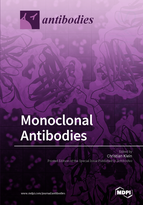Monoclonal Antibodies
A special issue of Antibodies (ISSN 2073-4468).
Deadline for manuscript submissions: closed (31 October 2017) | Viewed by 135606
Special Issue Editor
Interests: immunotherapy of cancer; bispecific antibodies; T cell bispecific antibodies
Special Issues, Collections and Topics in MDPI journals
Special Issue Information
Dear Colleagues,
Monoclonal antibodies are established in clinical practice for the treatment of cancer, and autoimmune and infectious diseases. The first generation of antibodies has been dominated by classical IgG antibodies, however, in the last decade, the field has advanced, and, nowadays, a large proportion of antibodies in development have been engineered. This Special Issue on "Monoclonal Antibodies" will cover original manuscripts and reviews in the field of the development of classical monoclonal antibodies that address novel biology, as well as progress in the engineering of novel antibody formats, including antibody drug conjugates, bispecific antibodies, and antibody-like scaffolds.
Dr. Christian Klein
Guest Editor
Manuscript Submission Information
Manuscripts should be submitted online at www.mdpi.com by registering and logging in to this website. Once you are registered, click here to go to the submission form. Manuscripts can be submitted until the deadline. All submissions that pass pre-check are peer-reviewed. Accepted papers will be published continuously in the journal (as soon as accepted) and will be listed together on the special issue website. Research articles, review articles as well as short communications are invited. For planned papers, a title and short abstract (about 100 words) can be sent to the Editorial Office for announcement on this website.
Submitted manuscripts should not have been published previously, nor be under consideration for publication elsewhere (except conference proceedings papers). All manuscripts are thoroughly refereed through a single-blind peer-review process. A guide for authors and other relevant information for submission of manuscripts is available on the Instructions for Authors page. Antibodies is an international peer-reviewed open access quarterly journal published by MDPI.
Please visit the Instructions for Authors page before submitting a manuscript. The Article Processing Charge (APC) for publication in this open access journal is 1800 CHF (Swiss Francs). Submitted papers should be well formatted and use good English. Authors may use MDPI's English editing service prior to publication or during author revisions.
Keywords
- monoclonal antibodies
- engineered antibodies
- bispecific antibodies
- antibody drug conjugates
- antibody-like scaffolds







